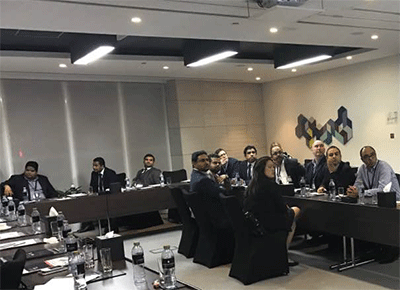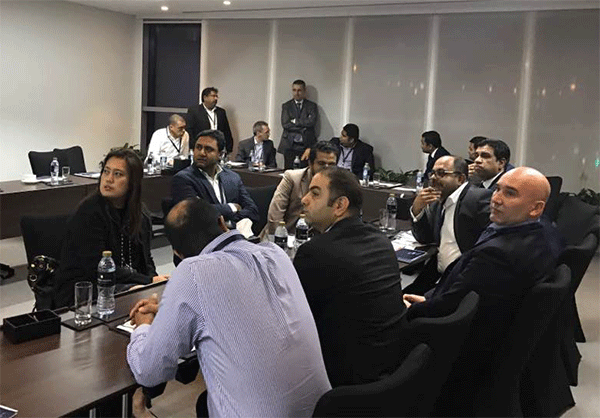 Business Partnering, the very essence of Financial Planning & Analysis (FP&A), continues to prove one of the most challenging aspects of the FP&A professional’s role. In simple terms, relationship building with Senior Management sometimes lacks the impetus required to empower the collaborative psychology an organisation needs to identify, facilitate and sustain growth.
Business Partnering, the very essence of Financial Planning & Analysis (FP&A), continues to prove one of the most challenging aspects of the FP&A professional’s role. In simple terms, relationship building with Senior Management sometimes lacks the impetus required to empower the collaborative psychology an organisation needs to identify, facilitate and sustain growth.
A balmy Dubai evening welcomed almost 30 senior Finance and FP&A professionals from across the UAE to join the latest FP&A Board at the Intercontinental Dubai Marina hotel. The roundtable was the latest in a series of regional gatherings organised by Larysa Melnychuck (MD of the FP&A Trends Group) with the aim of guiding the development and promotion of best practices in FP&A. Three hours of insightful, hot discussion and debate centred around the reasons why business partnering continues to prove such an obstacle for FP&A folk and the organisations they work for.
The agenda for the evening, Business Partnering and the Challenges Faced by FP&A professionals, addressed how building and sustaining internal business relationships, that can make a real and valuable difference to the success of their organisations, is something so many FP&A professionals and their business peers continue to struggle with.
Keynote speaker Samipendra Chaudhury, CFO at Nielsen Emerging Markets, shared his insights on FP&A business partnering and how to overcome its challenges:
‘’I feel one of the biggest challenges facing the FP&A department is to think beyond the obvious roles we are expected to play. We have an urgent need to use some of the modern data analytics capability and therefore being able to provide actionable insights, which the Operations and Commercial teams can act upon now vs. just being a rear view mirror reporting.
A great way to start this to build a partnership with the business teams and also understand the complexity and constraints they face. The finance community is guilty of having an inward-looking approach. In my personal experience, I have seen the less we come across as watchdogs and more as an enabler it creates a more collaborative approach and FP&A is seen as problem solvers’’
What is FP&A business partnering and why is it so important? A Business Partner (BP) is a professional who works alongside his/her peers representing other business areas, supporting and contributing to the strategic and operational decision-making of an organisation through insights that drive better business and performance.
The after effects of the financial crisis, digital transformation of businesses and their global markets, technological advances and increased competition across all industry sectors have changed the face of finance forever. Meeting the demands of a post-crisis world and ensuring the future success of an organisation whilst utilising the tools and skills available within a business, is key to success – a no brainer, or so you might think.
What are the most critical attributes of the FP&A business partnership? Stewardship was a strong theme to the evening, the responsibility for providing a vital support and think-centre, driving increased success across all business units through joined-up business thinking and agile logic. The ultimate objective of FP&A is to empower the CEO to make long-term, informed decisions around the future of the business. All this, along with identifying and mitigating risk during the course of a businesses journey, firmly places FP&A in the position of business reconnaissance.
Ramkumar Balasubramaniam, FPA Head of Financial Planning and Analysis and MI at Barclays suggests:
’The key challenge for FP&A professionals is to change the mindset from being ‘a partner function’ to ‘a business function’ working as one with business seamlessly to drive business decisions highlighting risks and opportunities and help shape the future strategy of the business’’
FP&A is neither solely strategy or financial, rather, a healthy mix of the two facilitated by analytics technology and the ability to collate, qualify and disseminate information quickly and accurately for the overall benefit of the organization.
Technology investment still remains a budget after-thought for some corporations. According to a recent study, only 30 percent of respondents say FP&A is a priority where accessing information and analytics capabilities is concerned. According to Jim Kaitz (President & CEO at the AFP) within his recent article CFOs, Don’t Get Left Behind. The Analytics Revolution is Here to Stay, organizations that spend less than 10 per cent of their budgets on technology say it takes an average of nearly 90 days to create a budget, 23 days to build a financial forecast and nearly 16 days to complete a rolling forecast. But companies that spend up to 49 per cent on forecasting technology complete those same tasks in 75 days, 17 days and 12 days respectively. And, not surprising, companies spending more than 50 per cent of their budgets on technology saw those numbers drop to 15, 3 and 2 days respectively. The numbers speak for themselves.
Maybe FP&A should not be aligned to one particular area of a business; should it operate independently from finance as an 'business ombudsman' of sorts, tasked only with the overall strategic success of the organization? Does it even belong ‘pigeonholed’ within finance? Are we at the horizon of a whole new piece of organizational structure separate to the norm? What we do know is the skill-sets historically found within finance are just some of what’s needed to drive a successful, collaborative FP&A function. Financial acumen, data analytics skills, commercial awareness, operational understanding, product & industry knowledge, not forgetting great people skills are just some of the reasons why we increasingly see a larger number of FP&A Heads now reporting direct to the CEO and their departments separating away from the standard finance function.
Digital disruption is acting as a catalyst for change – all functional data including sales, supply chain finance, customer click stream data – all collated into one communicable format. To stay ahead of the game, FP&A needs to understand their business data, be able to interpret that data accurately and present its capabilities to drive decision-making in a clear and illustrative manner.
Investment in people and their professional development also contribute heavily to shaping the leaders of tomorrow – statistics indicate over 33% of CEOs come from a finance background. Retaining the best talent plays a big part in the long-term success and value-add of the FP&A function. Fully formed business partnerships take time to shape and grow, they don’t happen overnight. Investment in professional development programmes such as AFP’s globally recognized FP&A Certification help improve and standardize core competencies, retain top talent and build succession plans through reward and recognition. The cost of replacing FP&A talent far outweighs investing in keeping that talent onboard.
Conclusion Fully integrated FP&A has a distance to go. Changing the mind-set of how senior management teams and boards perceive and approach the value-add FP&A brings to a business will be the real boon. For those of us old enough to remember the two decades old British Telecom mantra…..’it’s good to talk’, maybe that’s exactly what FP&A professionals need to do when seeking buy-in from their business peers. Treating internal clients (business partners) as you would external clients (customers) is a good place to start and responsibility for driving that philosophy lands firmly in the lap of the CEO and CFO.
"FP&A is the glamorous business partner, it's not just finance" – Mohammed Fouad, Global Trade CFO at OCI NV

Business culture & ‘DNA’, as we know, has a direct correlation to the success of any organisation. It can dictate how people feel about going to work in the morning; it affects productivity, influences management and strategic decisions and functions right across an organisation.
Encouraging FP&A professionals to ‘just talk’ with their BP’s, get to know each other and take the time to present how FP&A can help business partners succeed and contribute to the future direction of the business can help negate a reluctance to co-operate. If you want to implement and manage change then you need to sell the benefits of that change and keep business partners informed as you move through the process and achieve wins – maybe being able to sell is the rarely mentioned but increasingly necessary string to the FP&A proverbial bow!
Special thanks to sponsors Adam Man-Cheung, Director at Michael Page International, the world’s leading specialist finance recruitment agency and the Association for Financial Professionals (AFP), a not-for-profit Association committed to the professional success of their 150,000 global subscribers. For more information on FP&A Certification and finance specific professional development programmes, please contact Anne-Marie Rice (EMEA Director) at amrice@afponline.org
Copyright © 2017 Association for Financial Professionals, Inc.
All rights reserved.






